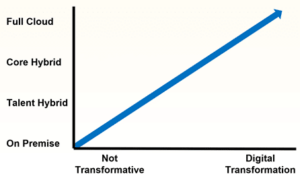Most executives have a positive outlook on how their digital transformation plans can affect their business prospects. But HR leaders are, by far, the most optimistic when considering cloud technology to enable new opportunities to increase workplace flexibility, control costs, and accelerate strategic decision-making.
Unfortunately, frustration is growing on the other side of this cloud adoption boom. In a PwC survey, 53% of surveyed executives believe their organizations have yet to realize substantial value from their cloud investments, even though 56% view it as a strategic platform for growth and innovation.
As with any digital business transformation, cloud technology is a critical enabler. It connects systems, data, devices, and emerging technology to allow companies to operate more quickly, innovatively, and with more agility. However, and more importantly, the cloud offers people and their organizations a gradual approach to creating and establishing lasting change in how they work.
Closing the Cloud Value Gap to Drive True Change
There is great power in allowing people to choose how they transition to new technology – but not everyone is ready to take the leap all at once. Using technology to evolve how employees think, collaborate, and work enables organizations to align their digital strategy with business needs, address the next digital talent divide, and advance business goals as they shift. Ultimately, they build a level of trust that compels people to embrace change more openly.
For that reason, some organizations view the cloud as a viable, long-term choice for HR transformation. The modular nature of cloud-based human experience management (HXM) technology, such as SAP SuccessFactors solutions, allows organizations to take a step-by-step deployment approach. They can choose to deploy one module at a time, allowing users to adapt their work habits gradually. Then, adoption can be expanded slowly to eventually cover the entire employee life cycle fully in the cloud.
Yet, one of the challenges most companies face is knowing and understanding which deployment options can best help them move at their pace to the cloud. In short, there are three to consider:
Talent Hybrid
A first entry point for cloud adoption that delivers immediate value is running talent management in the cloud and maintaining processes for core HR, payroll, time management, and benefits on premise. By using talent management solutions and people analytics, HR organizations can adjust or completely reimagine recruiting, onboarding, performance and goals management, compensation, learning, and succession.
Core Hybrid
The core hybrid option is recommended for HR organizations that want to move their HR core processes to the cloud but keep payroll and time management on premise. This deployment approach allows HR leaders to rethink their talent management capabilities, as done with a talent hybrid. Organizations can add cloud-based personnel administration and organizational management solutions and integrate data with their existing instance of SAP SuccessFactors HXM Suite. Then, they can keep the payroll and time management solutions from the suite on premise without disruption.
Often, organizations that embrace the talent hybrid or core hybrid approach will have further objectives related to the adoption of cloud infrastructure. In response, SAP has developed a hybrid transition scenario, the SAP Human Capital Management solution for SAP S/4HANA Cloud, on-premise edition.
When using the solution, SAP customers with complex time and payroll requirements are afforded the ability to move to SAP ERP Human Capital Management (SAP ERP HCM) as a standalone or embedded in their enterprise resource planning (ERP) stack into SAP S/4HANA Cloud, private edition. Plus, they can realize the full benefit from cloud infrastructure and subscription-based licensing. Furthermore, their deployment of human capital management applications for payroll, time, and attendance are left undisrupted.
Full Cloud
The full cloud option is what most companies envision when considering true HR transformation through a move to the cloud. HR organizations can bring together all their core HR-related data and applications – including payroll and time management – and move them all at once with a modern, cloud-based solution.
The move to a full cloud deployment approach for HR may seem daunting. But organizations can ease the transition by taking the time up front to identify the goals they wish to achieve through transformation and the value proposition associated with adopting cloud solutions, as well as consider risks realistically. These early measures can help ensure that the true benefits of “going to the cloud” are observed.
Some of the key benefits of a full cloud transformation include:
- Innovating quickly, meaningfully, and with a low total cost of ownership innovation
- Reimagining business processes and taking advantage of standardized best practices
- Eliminating the need to convert outdated and legacy HCM processes and solution configurations
- Adopting a complete set of modern, cloud-native capabilities that improve the speed and scale of HR processes and application experiences
While results such as immediate savings in operating costs and simplified contracting with the solution provider are compelling, users may need more time to fully accept the transition from on premise to the cloud before realizing additional value from the investment.
Advancing Every Stage of an Evolving HR Function
The more HCM-related processes managed in the cloud, the better the employee experience. Meanwhile, HR staff, organizational management, and executive leadership have the integrated employee data they need to make intelligent decisions in recruiting, skill development, future succession, and compensation competitiveness. This, in turn, enables businesses to better attract, engage, and retain top talent and inspire the entire workforce as HR evolves from managing people to optimizing the human experience of everyday work.
This perspective demonstrates the advantages of slowly moving HR to the cloud. Every HR leader has a specific destination in mind for transforming the employee experience and supporting it. But choosing the right processes, applications, and experiences along the way is challenging when locked in a specific environment – regardless of employee readiness. Instead, their organizations need to plan, imagine, and design the HR landscape in ways that are relevant, engaging, and productive to the workforce.

To help our customers reframe their concept of the cloud, SAP offers the SAP Human Experience Management Movement program. It empowers organizations with the on-premise SAP ERP Human Capital Management solution to transition to cloud-based SAP SuccessFactors solutions with a steady expansion of capabilities, as they are needed.
Supporting People in a Rapidly Changing World
Providing clear guidance, predictable outcomes, faster time to value, and access to tools, assets, and services helps ease and accelerate the complete migration journey with less complexity. Our customers can then advance their core HR capabilities with improved configurability and localization, such as supporting payroll innovation with little to no disruption and streamlining data integration between on-premise and cloud solutions.
And whenever a migration to the cloud is simpler and faster, HR organizations open themselves to new possibilities to rethink, readjust, and drive HR transformation that is powerfully relevant, meaningful, and timely.
Let us help make your cloud HXM migration as easy as possible. Learn more about the SAP HXM Movement program.



